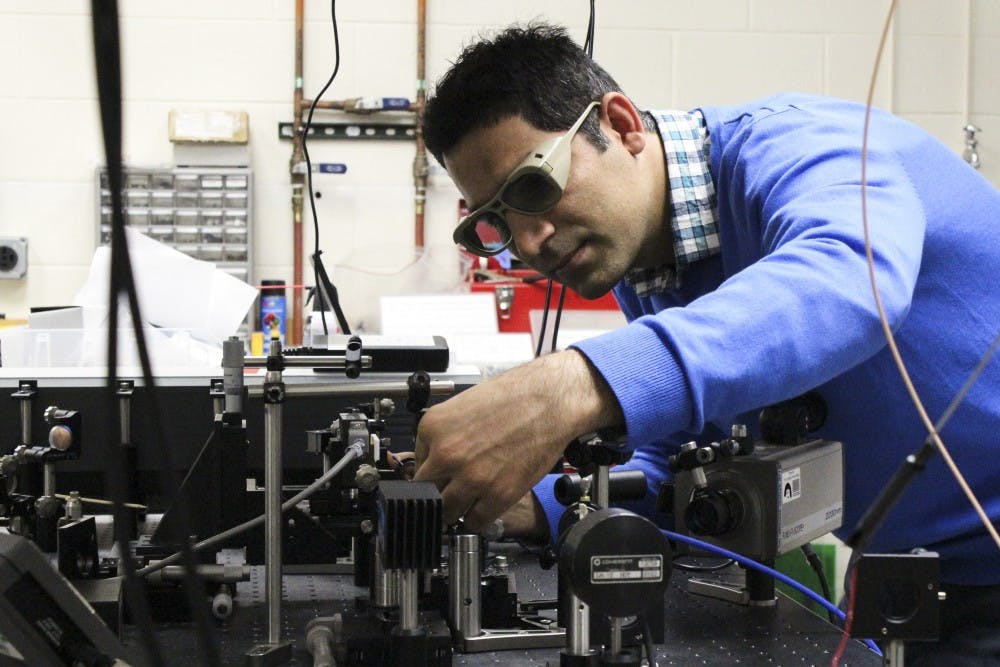Using crystals and lasers, a team of scientists headed by Department of Physics and Astronomy professor Mansoor Sheik-Bahae has developed and is currently fine-tuning a novel method known as optical refrigeration for cooling solids to extremely low temperatures.
“It is fair to say that our team is the leader in terms of achieving the lowest temperature and advancing this science into a practical technology,” Sheik-Bahae said.
The system works through the transfer of energy in the form of either heat or light. To reach these extreme temperatures, a high-powered laser of a very specific color, or wavelength, is directed into a crystal, which absorbs the laser light and fluoresces. In other words, energy is transferred into the crystal as light and is then immediately transferred back out in the form of light.
The trick, however, lies in how different wavelengths of light correspond to different amounts of energy. Because the energy of a light particle, or photon, coming out of the crystal is a little bit greater than the energy absorbed from the laser photons, the crystal must give up some of its own energy to make that new wavelength of light. That extra energy comes from the thermal energy of the crystal, or its heat, which is carried away and causes the crystal to cool down.
While the laws of physics allowed scientists to predict that this was a possibility more than 80 years ago, actually constructing a system to turn theory into reality was another thing entirely. After numerous attempts by other groups, the effect was first experimentally observed at Los Alamos National Lab in 1995, Sheik-Bahae said.
Since then, working in collaboration with LANL, he said his group has succeeded in lowering the temperature of a crystal to around -184° C (-300° F) — already an extremely cold temperature — and they’re working on forcing it even lower.
“The idea here that one can cool matter with laser beams was predicted many, many years ago,” Sheik-Bahae said. “But the challenge has been some intricate tricks that we had to play with to get it to these low temperatures and make it a reality.”
According to a recent paper by Sheik-Bahae’s group, published in Optics Express, those tricks have included getting the make-up of the crystal just right: to have a very high purity and contain small pieces of ytterbium, a rare earth element. Then there’s the tricky matter of attaching whatever they are cooling, and the whole thing must be performed in an airless vacuum.
Cooling to what are known as “cryogenic” temperatures — below approximately -150° Celsius — is important for operating many extremely sensitive pieces of equipment, Sheik-Bahae said. Something that might benefit from this technology is infrared sensors, which are often used to detect heat given off by objects or individuals, and in more simple versions they’re the technological basis of things like night-vision goggles. More complex, sensitive infrared sensors work much better when they are cooled, since any heat in their environment shows up as background noise, making the signals harder to read.
Traditional methods for cryo-cooling involve using “moving parts” such as a machine with a pump to circulate something like liquid nitrogen. This is problematic for a few reasons, including vibrations caused by these moving parts that can interfere with the sensitive machinery the system is cooling, and also the general bulkiness of this system, he said.
“[Our] technology would be the only solid-state [cryo-cooling system], meaning that there are no moving parts, there is no pump, there is no liquid,” Sheik-Bahae said. “A highly promising application that has emerged recently is the use of such vibration-free cryo-coolers for the ultra-stable lasers developed by National Institute of Standards and Technology. In the long term, one may also envision exploiting this technology for cooling superconducting electronics.”
Get content from The Daily Lobo delivered to your inbox
Their system has the potential to be more compact than traditional methods, lighter in weight and longer lasting.
“It has been a unique opportunity for me to be able to work in Professor Sheik-Bahae’s lab,” said graduate student Mohammed Ghasemkhani. “With his great knowledge of and experience with optical refrigeration, our team in UNM’s Physics and Astronomy Department is the world’s leading lab and holds the lowest record temperature ever achieved in the area of optical refrigeration.”
Sheik-Bahae said his group is currently working with a local company called Thermodynamic Films to commercialize the system and adapt it to different applications. A working prototype called CryoRay is currently under development jointly by UNM and TDF teams.
Lauren Topper is a freelance reporter at the Daily Lobo. She can be contacted at news@dailylobo.com, or on Twitter @DailyLobo.






